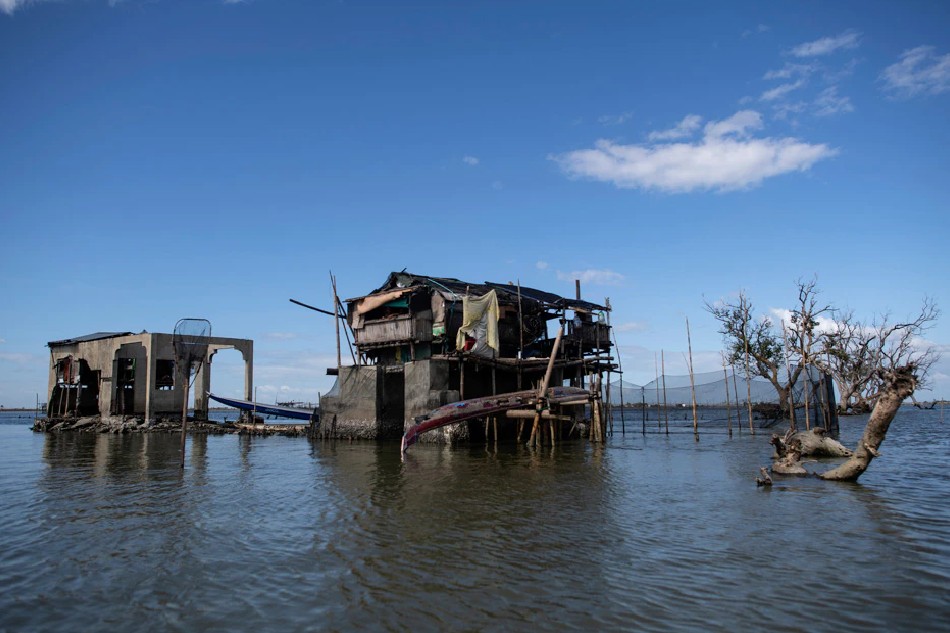PAGASA scientist reiterates warning on rising sea levels in PH amid climate change | ABS-CBN

Welcome, Kapamilya! We use cookies to improve your browsing experience. Continuing to use this site means you agree to our use of cookies. Tell me more!
PAGASA scientist reiterates warning on rising sea levels in PH amid climate change
PAGASA scientist reiterates warning on rising sea levels in PH amid climate change
Job Manahan,
ABS-CBN News
Published Apr 30, 2022 04:35 PM PHT
|
Updated Apr 30, 2022 04:50 PM PHT
MANILA — The sea level in the Philippine Sea has risen to about 12 centimeters or nearly 5 inches in the past 20 years, a PAGASA climate scientist said on Saturday.
MANILA — The sea level in the Philippine Sea has risen to about 12 centimeters or nearly 5 inches in the past 20 years, a PAGASA climate scientist said on Saturday.
The Philippine Sea had an average yearly increase of 5.7 to 7 millimeters between 1993 to 2015, Dr. Marcelino Villafuerte said, citing studies conducted using satellite data for such period.
The Philippine Sea had an average yearly increase of 5.7 to 7 millimeters between 1993 to 2015, Dr. Marcelino Villafuerte said, citing studies conducted using satellite data for such period.
This is "double" the global average rate of around 2.8 to 3.6 milimeters yearly, as the global temperature continues to rise, he noted.
This is "double" the global average rate of around 2.8 to 3.6 milimeters yearly, as the global temperature continues to rise, he noted.
"In another statement po ‘no related doon sa COP26 meeting, it was said that our country is sinking four times faster than the global average," Villafuerte said in a public briefing.
"In another statement po ‘no related doon sa COP26 meeting, it was said that our country is sinking four times faster than the global average," Villafuerte said in a public briefing.
ADVERTISEMENT
Experts have observed the rise of sea levels in the country's eastern portions. He said this was seen in Cebu, while the highest increase was reported around Manila Bay.
Experts have observed the rise of sea levels in the country's eastern portions. He said this was seen in Cebu, while the highest increase was reported around Manila Bay.
"Pero ang main reason po for that ayon sa mga pag-aaral ng mga siyentista, mga kasamahan natin sa UP, ay iyong ground water extraction naman, iyon po, na siyang nagpapababa naman ng lebel ng lupa sa gawing coastal communities po ng Manila Bay," he explained.
"Pero ang main reason po for that ayon sa mga pag-aaral ng mga siyentista, mga kasamahan natin sa UP, ay iyong ground water extraction naman, iyon po, na siyang nagpapababa naman ng lebel ng lupa sa gawing coastal communities po ng Manila Bay," he explained.
Reducing carbon emissions and shifting to clean energy could help reduce the rising global temperatures, according to the scientist.
Reducing carbon emissions and shifting to clean energy could help reduce the rising global temperatures, according to the scientist.
"Kung magpapatuloy po ang pagtaas ng global temperature... iyong mga nararanasan po nating mga extreme events, katulad halimbawa ng malalakas na ulan na maaaring magdulot ng pagbaha, mahabang tagtuyot... mapaminsalang mga bagyo at iyong sea level rise... ay maaari pang lumala," he added.
"Kung magpapatuloy po ang pagtaas ng global temperature... iyong mga nararanasan po nating mga extreme events, katulad halimbawa ng malalakas na ulan na maaaring magdulot ng pagbaha, mahabang tagtuyot... mapaminsalang mga bagyo at iyong sea level rise... ay maaari pang lumala," he added.
A report by Agence France-Presse noted that as of 2019, areas north of Manila like provinces Pampanga and Bulacan have sunk 4 to 6 centimeters (1.5 to 2.4 inches) a year since 2003, based on satellite monitoring.
A report by Agence France-Presse noted that as of 2019, areas north of Manila like provinces Pampanga and Bulacan have sunk 4 to 6 centimeters (1.5 to 2.4 inches) a year since 2003, based on satellite monitoring.
ADVERTISEMENT
Red Constantino, director of the Institute for Climate and Sustainable Cities, has warned of the dangers rising sea levels have for the country, most especially during storm surges.
Red Constantino, director of the Institute for Climate and Sustainable Cities, has warned of the dangers rising sea levels have for the country, most especially during storm surges.
Around 20 tropical cyclones pound the country yearly.
Around 20 tropical cyclones pound the country yearly.
“The Philippines will be twice or certainly above the global levels. And that is going to be disastrous to an archipelagic country like us,” said Constantino.
“The Philippines will be twice or certainly above the global levels. And that is going to be disastrous to an archipelagic country like us,” said Constantino.
Filipino green campaigners have expressed concerns about a recent study released by the United Nations' (UN) climate experts, warning about a catastrophic climate change by 2025 if carbon emission levels remain unchanged.
Filipino green campaigners have expressed concerns about a recent study released by the United Nations' (UN) climate experts, warning about a catastrophic climate change by 2025 if carbon emission levels remain unchanged.
They called on the public to vote for leaders in the upcoming elections who would prioritize climate justice and measures promoting a "green agenda," saying this would be a vote for survival.
They called on the public to vote for leaders in the upcoming elections who would prioritize climate justice and measures promoting a "green agenda," saying this would be a vote for survival.
Read More:
rising sea levels
climate change
environment
PAGASA
climate crisis
sea level rise
sea level
Marcelino Villafuerte
ADVERTISEMENT
ADVERTISEMENT


